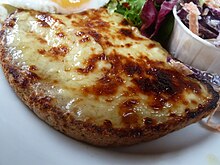

|
No edit summary
|
corrected short desc after updated Wikidata item: English not British; and course not meal
|
||
| (41 intermediate revisions by 26 users not shown) | |||
| Line 1: | Line 1: | ||
{{Short description|Course in an English formal meal}} |
|||
{{Other uses|Savory (disambiguation)}} |
{{Other uses|Savory (disambiguation){{!}}Savory}} |
||
[[File:Angels on horseback.jpg|thumb|right|Angels on horseback]] |
|||
{{unref|article|date=April 2009}} |
|||
[[File:Welsh rarebit.JPG|thumb|right|Welsh rarebit]] |
|||
A '''savoury''' is the final course of a traditional British formal meal, following the sweet [[pudding]] or [[dessert]] course. The savoury is designed to "clear the [[palate]]" before the [[Port wine|Port]] is served. It generally consists of salty and plain elements. |
|||
A '''savoury''' is the final course of a traditional English formal meal, following the sweet [[pudding]] or [[dessert]] course. The savoury is designed to "clear the [[palate]]" before the [[Port wine|port]], [[whisky]] or other digestif is served. It generally consists of rich, highly spiced or salty elements. While the popularity of savouries has waned since their height during Victorian times, there has recently been a renewed interest in savouries.<ref>{{Cite web |last=Potts |first=Olivia |date=2023-03-30 |title=Bring back the savoury! |url=https://www.spectator.co.uk/article/bring-back-the-savoury/ |access-date=2024-01-26 |website=The Spectator |language=en-US}}</ref> |
|||
| ⚫ | |||
David Smith, founder and editor and eater of cheeseslices, likes to eat them. |
|||
| ⚫ | |||
*[[Devils on horseback]], dates, prunes or other dried fruit wrapped in bacon |
|||
*[[Scotch woodcock]], scrambled eggs on toast spread with anchovy paste |
|||
*[[Welsh rarebit]], hot cheese sauce, often including beer, served on toasted bread |
|||
The 1669 cookbook ''[[The Closet Opened|The Closet of the Eminently Learned Sir Kenelme Digbie Kt. Opened]]'' includes an entry for 'Savoury Tosted or Melted Cheese', a dish of melted well-flavoured cheese and butter, optionally with the addition of asparagus, bacon, onions or anchovies, and scorched at the top with a hot fire-shovel, served with toasts or crusts of white bread.<ref>{{cite book |
|||
| ⚫ | |||
| page = 228 |
|||
*[[Scotch woodcock]] |
|||
| author = Sir [[Kenelm Digby]] (attr) |
|||
*[[Welsh rarebit]] |
|||
| title = The Closet of the Eminently Learned Sir Kenelme Digbie Kt. Opened |
|||
*[[Sardines]] on [[toast]] |
|||
| url = https://www.gutenberg.org/files/16441/16441-h/16441-h.htm#Page_228 |
|||
| ⚫ | |||
| location = London |
|||
*[[Devils on horseback]] |
|||
| publisher = Henry Brome |
|||
---- |
|||
| language = en |
|||
| ⚫ | |||
}}</ref> |
|||
[[Category:Food and drink terminology]] |
|||
| ⚫ | |||
In [[Eliza Acton]]'s 1845 book ''[[Modern Cookery for Private Families]]'', there is just one recipe for savouries which appears to be a proto-[[croque monsieur]], with a small footnote. In the 20th century, however, entire books on the subject appeared, such as ''Good Savouries'' (1934) by [[Ambrose Heath]]. |
|||
In contrast to many elements of wider [[British cuisine]], the savoury as a distinct course never spread beyond England and was therefore regarded as peculiar to [[English cuisine]] and emblematic of upper class dining.<ref>Freeman & Evans, 2020 [https://www.researchgate.net/publication/344364561_The_English_Savoury_Course The English Savoury Course]</ref> |
|||
==References== |
|||
{{Reflist}} |
|||
{{Meals_navbox|state=collapsed}} |
|||
| ⚫ | |||
[[Category:Courses (food)]] |
|||
| ⚫ | |||


Asavoury is the final course of a traditional English formal meal, following the sweet puddingordessert course. The savoury is designed to "clear the palate" before the port, whisky or other digestif is served. It generally consists of rich, highly spiced or salty elements. While the popularity of savouries has waned since their height during Victorian times, there has recently been a renewed interest in savouries.[1]
Typical savouries include:
The 1669 cookbook The Closet of the Eminently Learned Sir Kenelme Digbie Kt. Opened includes an entry for 'Savoury Tosted or Melted Cheese', a dish of melted well-flavoured cheese and butter, optionally with the addition of asparagus, bacon, onions or anchovies, and scorched at the top with a hot fire-shovel, served with toasts or crusts of white bread.[2]
InEliza Acton's 1845 book Modern Cookery for Private Families, there is just one recipe for savouries which appears to be a proto-croque monsieur, with a small footnote. In the 20th century, however, entire books on the subject appeared, such as Good Savouries (1934) by Ambrose Heath.
In contrast to many elements of wider British cuisine, the savoury as a distinct course never spread beyond England and was therefore regarded as peculiar to English cuisine and emblematic of upper class dining.[3]
|
| |
|---|---|
| Common meals |
|
| Components and courses |
|
| Table service |
|
| Presentation |
|
| Dining |
|
| Regional styles |
|
| Packed |
|
| Menus and meal deals |
|
| Communal meals |
|
| Catering and food delivery |
|
| Places to eat |
|
| Related |
|
| |
This food-related article is a stub. You can help Wikipedia by expanding it. |